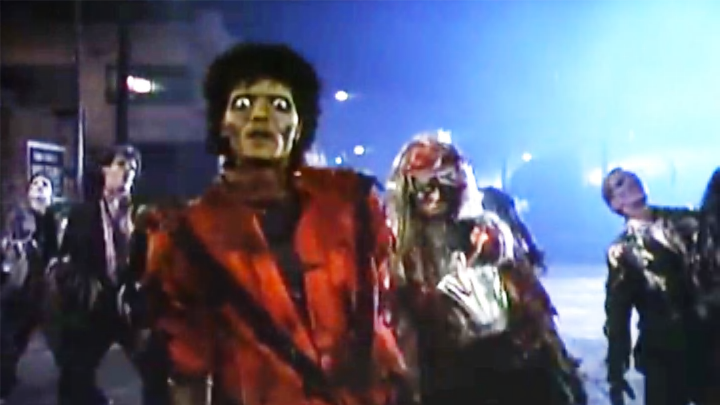Why 'Thriller,' the Most Iconic Halloween Music Video Ever Made, Was Released in December

With the Thanksgiving leftovers long gone and holiday cards starting to roll in, now is the perfect time to pop some popcorn, pour some eggnog, and park yourself in front of the tube for … a nearly 14-minute music video starring dancing zombies and a teen werewolf? Believe it or not, Michael Jackson’s landmark "Thriller" video premiered on December 2, 1983—weeks after the holiday it’s now synonymous with.
How could Jackson not have unleashed "Thriller" on Halloween? The explanation for this apparent monster of a marketing fail seems to lie in the project’s timeline. The idea for the video wasn’t spawned until the summer of 1983. By this time MJ’s Thriller album—out since the previous November—had already sold roughly 10 million copies and sat atop the Billboard 200 album chart for 17 straight weeks (February 26 to June 18, 1983). Any normal pop star would’ve been cool with seeing it slip to No. 2, but as Jackson would say in the "Thriller" video, he was "not like other guys."
He wanted badly to reclaim the No. 1 spot, and his bosses at Epic Records knew that neither of Thriller’s final two scheduled singles, "Human Nature" or "P.Y.T.," would get him there. They also knew his previous hits "Billie Jean" and "Beat It" had gotten nice little boosts from their memorable music videos. (Shout-out to light-up sidewalks and dancing gangsters.) Epic’s head of promotions, Frank DiLeo, suggested Jackson shoot another promo clip—this time for the album’s title track. "It’s simple," DiLeo recalled telling Jackson in a Vanity Fair interview. "All you’ve got to do is dance, sing, and make it scary."
Fair use, via Wikimedia Commons
But it wasn’t quite so simple. In August of 1983, Jackson phoned up John Landis, the director behind 1978’s Animal House, 1980’s The Blues Brothers, and 1983’s Trading Places. Landis had also helmed An American Werewolf in London, a 1981 horror-comedy Jackson had seen, loved, and recognized as a good template for "Thriller." Approached with the idea of shooting the video, Landis suggested they do something more ambitious and make a short film worthy of theatrical release. They’d get Hollywood makeup and costumes and shoot on 35mm—the whole bit. Jackson was thrilled.
The trouble was, someone had to pay for it. Landis's original budget was $900,000—far more than Epic was willing to shell out for the seventh single on an album that was nearing its one-year anniversary. Landis and his team next approached MTV, but execs there balked, fearing it would set a dangerous precedent to pay for something they’d always gotten for free.
Jackson nearly put the money up himself, but then his lawyer, John Branca, and Landis’s production partner, George Folsey Jr., came up with a brilliant idea: If they shot both a "Thriller" video and a making-of documentary, they’d have an hour’s worth of fresh content featuring one of the world’s hottest entertainers. Surely, networks would be willing to pay for that, right?
Indeed they would. MTV dropped $250,000 to air the vid and doc exclusively for a week, and Showtime coughed up $300,000. It was now nearly September, and Landis and Jackson had their financing. The next step was figuring out what, exactly, they were going to shoot.
In the six weeks leading up to October 11, when filming began in Los Angeles, Jackson’s team scurried to complete pre-production on the most ambitious music video the world had ever seen. Landis co-wrote the story with Jackson and hired his costume designer wife, Deborah Nadoolman Landis (who’d dressed Harrison Ford for Raiders of the Lost Ark and made John Belushi's "College" sweatshirt happen) to handle costumes. He also re-enlisted "Beat It" choreographer Michael Peters, who began dreaming up dances the undead might do.
Principal photography took place throughout October, and given the scope of what they were creating, a Halloween premiere probably never would have been possible. It certainly would’ve suited the material, though. As just about everyone on the planet knows, "Thriller" features Jackson transforming into two creatures: a werewolf (or, technically, a "werecat") in the film-within-a-film opening segment, then a surprisingly nimble zombie in the oft-reenacted second half. Joining Jackson in both sequences is actress Ola Ray, a former Playboy playmate (who has admitted to some on-set smooching with her co-star).
But while Jackson was game to share the screen with a Playboy model, the video’s supernatural themes didn’t square with his Jehovah’s Witness beliefs. At one point, weeks before the premiere date, Jackson called Branca and asked him to destroy the negatives. The church had learned of the video and threatened to excommunicate him. Branca saved the day by suggesting they slap on the now-famous disclaimer: "Due to my strong personal convictions, I wish to stress that this film in no way endorses a belief in the occult."
MJ’s warning gave the video an extra level of intrigue—like the images to follow were really going to mess you up. Final frame notwithstanding, "Thriller" is actually pretty tame, but it sank its fangs into the world’s imagination. Aided by constant MTV airplay, the video transformed Jackson into a new kind of celebrity and, yes, shocked Thriller back to life. The album reclaimed the No. 1 position on December 24 and stayed there through April of 1984 for a total of 37 weeks at the top. By the end of that year, it had sold 33 million copies.
Over the years, "Thriller" has sold more than 9 million home video copies (a Guinness World Record) and topped numerous lists of the greatest and most influential music videos. In 2009, it was selected for the National Film Registry, and this past Halloween, Barack and Michelle Obama did the zombie dance at the White House.
Simply put: "Thriller" devoured pop culture. But just think of how much bigger it would’ve been had it dropped on Halloween.